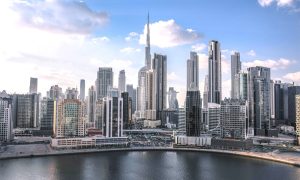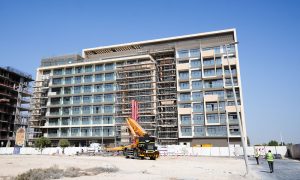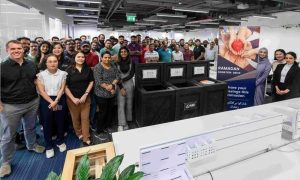Working at height: Creating a stronger fall protection chain
MSA Safety’s Nicolas Abry on the responsibilities of the whole supply chain to ensure people go home safely

There’s no escaping the fact that working at height can carry significant risk. Preventing accidents from falls relies on several stakeholders who all play a vital role. Nicolas Abry, Sales Leader – Fall Protection Systems and Solutions MEAIRR at MSA Safety, sets the current work at height scene in the Middle East and explains how and why each link in the fall protection safety chain – specifiers, contractors, system installers and end-users – has a responsibility to minimise risk and help ensure people go home safely at the end of each day.
Despite the best planning and precautions to mitigate danger, the possibility of a fall is ever-present. Should the unthinkable happen, workers’ lives are at stake. That’s why, whether you’re a specifier, contractor, system installer or end-user, you have a professional, legal and moral obligation to deliver the safest work at height solution possible.
Together, these stakeholders form what MSA refers to as the “working at height safety chain”. Any weak link in this chain can compromise safety and potentially cost lives. If you’re a specifier, specify the very best fall protection equipment and insist that it’s stuck with. If you’re a contractor, don’t change the specification in favour of an inferior product and always commission competent, experienced systems installers. And, if you’re an end-user, insist on using the highest quality, safest equipment and receiving the very best training. Don’t settle for anything less than the best. Your life may depend on it.
Accident prevention: Regional Trends
It will be no surprise to learn that the never-ending stream of construction projects in the Middle East region have historically accounted for most accident-prone environments. In the Kingdom of Saudi Arabia, 48% of occupational injuries in 2011 happened in the construction industry1, whilst in Kuwait 33.2% of construction injuries in 2007 were as a result of falls from height1. Limited awareness is a key contributor. A report found that 69% of construction companies in the Dubai Municipality lack understanding of Health and Safety policy importance2.
By and large, Health and Safety legislation and safe working practices in the Middle East are now well established and comprehensive, mirroring standards adopted in the UK and Europe. Since the implementation of the 2009 ‘Code of Construction Safety Practice’, Dubai’s Municipality Environment and Safety Department reports construction fatalities have declined.
That said, fall protection still remains a relatively new safety discipline within the region, and awareness of different fall protection systems and Personal Protection Equipment (PPE) can vary widely. The result is a general lack of knowledge in the market around the importance of specifying suitable products for different working at height scenarios. Whilst adopting a ‘one size fits all’ or ‘tick the box’ approach to equipment may be simple and attractive for some, it is not an effective way to mitigate risk. So, let’s look at the responsibilities and expectations of each stakeholder in the working at height safety chain.
Starting the safety chain: Specifiers
One of the most important links in the working at height safety chain is defining the appropriate fall protection system specification for a building or structure at the outset. Parties controlling this specification may be independent, for example architects, consultants or engineers, or safety system industry professionals, such as professional installers. Any fully considered specification will have assessed the unique risks posed by the structure and considered the specific requirements needed for safe access and works. It will also ensure full compliance with all local and national health and safety and regulatory conditions.
Crucially, specifiers will identify those partners and manufacturers offering the most suitable systems and equipment for the application. In many cases, they will refer directly to manufacturers for technical clarification, and can therefore verify the quality, safety features and performance. For the Middle East region, adopting this specification regime is especially important for PPE. PPE should never be viewed by contractors merely as a commodity purchase. Thought must be given to the widely different quality, durability, wearability and safety performance characteristics between budget and more premium brands.
Second in line: Contractors
Contractors are arguably the most influential players in reducing (or instead increasing) fall protection risks. Why so? Because currently they have the power to execute the designated safety equipment specification or, should they so wish, elect to amend or reduce it. This so-called ‘specification switching’ is driven by two factors. Firstly, short-term commercial pressure (reducing cost to maintain margin); and secondly, lack of understanding regarding the implications of what they believe is simply a product or system substitution.
The ramifications are wide-ranging. Advanced engineering and rigorous testing set high-quality equipment apart. They guarantee optimum performance and full regulatory compliance spanning many years. Respected brands offer proven functionality, with robust solutions that maximise ease of use and reduce the risk of user error or equipment failure. In addition, inferior quality products typically wear, degrade or fail more quickly, requiring premature replacement and increasing Total Cost of Ownership. The moment a contractor switches a specification, it has the potential to place lives in jeopardy.
Making it happen: Installers
Whether it’s a new build or a retrofit project, the safety of fall protection equipment is only as robust as the quality of the installation. Quality installers will likely possess the experience and expertise to overcome any challenge they’re faced with. Installing equipment on new builds is typically more straightforward to plan and manage. If a specification has been prepared and is executed without change, any proposed equipment will already be fully compatible with variables such as the building’s design, construction materials, fixing points and load requirements. Installers are fully familiar with the manufacturer systems and will have undergone specialist training to ensure compliant practice through to sign-off.
Retrofit installations demand detailed preparatory investigation. Quality installers will conduct a thorough site survey before any work commences and share any unforeseen risks or findings that impact the choice or deployment of fall protection systems in a written report. Once equipment is installed, the installer will be responsible for commissioning, testing and ongoing maintenance and, in some cases, arranging user training.
The last, most precious link: End Users
Fall protection is installed for a reason: if working at height is to be safe, it has to be used. Quality training for end-users, preferably from an accredited provider, is as important as the equipment itself. What are the risks? Why has this particular equipment been chosen? How should the system be used? What happens if a rescue is needed? By law businesses, in accordance with Abu Dhabi’s Health Authority, need to have rescue plans in place for those working at height so that they are not solely reliant on the help of fire and rescue services in an emergency. The goal is creating users who understand working at height hazards and are confident (and willing) to use the systems and PPE provided.
Only one chance
Working at height demands a holistic approach to safety – an approach that sees each party in the chain playing their part. The more informed, educated and pro-active we all become about the choices and challenges facing the sector – from deterring ill-informed specification-switching to improving user competence with professional instruction and training – the more we reduce the risk of serious injury or even death from falls. Choose your fall protection partners and equipment carefully.
Quoted sources:
- Construction safety and health performance in Dubai: Michael Kosman Zekri
- Managing liability for worksite accidents: Jeremie Witt & Antonia Birt, Freshfields Bruckhaus Deringer LLP























